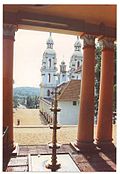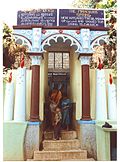St. Mary (Kuravilangad)
St. Maria (Kuravilangad) English called St. Mary's Forane Church , is a Catholic pilgrimage and parish church in Kuravilangad , Kottayam District , Kerala , India and goes back to a very early apparition of Mary with a spring. It is considered the oldest known place of pilgrimage for an apparition of Mary in the world.
history
The Church in India traces its origins back to the Apostle Thomas . He is said to have landed in Muziris (Kodungallur), in today's Kerala , in the year 52 , founded seven Christian communities along the Malabar coast and died as a martyr in Mailapur near Madras around 72 . What is certain is that the Church developed in India long before European colonial powers were active there. She followed the East Syrian liturgy. It is today's Thomas Christians who are divided into a larger Catholic and a smaller autocephalous part and make up a significant proportion of the population in Kerala.
It is part of the solid tradition of the Indian Church that St. Thomas converted several Brahmins in Palayur, one of his 7 church plantings , who then moved away from their temple. Their descendants later settled in Kuravilangad. This settlement is believed to be in the 2nd century and traditionally the year 105 is called the time of the apparition of Mary. At that time, Mary appeared to some shepherd children at the current location of the church, let a spring spring up and instructed them to work for the construction of a church at this place. Sometimes the apparition event is only set at the beginning of the 4th century, since the first historical traces at the pilgrimage site can be found from this time.
The spring rising from a rock is still there today (2012), the pilgrims drink from the water and wash or cross themselves with it. It has never dried up in living memory and has been given a chapel-like superstructure.
To the west of the spring is the pilgrimage and parish church of St. Mary. Its current imposing facade, with two mighty towers, dates from 1960, but the choir area from the 16th century. The demolition of most of the ancient sanctuary in 1955 is highly controversial and is now viewed as a significant cultural loss in Kerala. An inscription was discovered on an old bell tower which is dated to the year 337 and is the first reliable source for the foundation of the church. There is also a bell from the 16th century with the Syriac inscription Ameh dalaha (translated Mother of God ).
In 1687 the first local bishop of the Thomas Christians, Alexander de Campo , Vicar Apostolic of Malabar, was buried in front of the high altar . He came from the Kuravilangad parish and resided here from 1663 to 1687, making the local St. Mary's Church the center of the Catholic Thomas Christians for 25 years. In the church is a miraculous image of a very old, colored aggregate figure of Mary of granite, from the faithful Kuravilangad Muthiyamma called (Our Mother of Kuravilangad). The church was magnificently painted around 1600 and it was then also given its current high altars.
To the east above the pilgrimage church and spring of grace, Alexander de Campo had a chapel built during the time when he was pastor here before his episcopal ordination (around 1640), which was consecrated to St. Sebastian . After he chose Kuravilangad as his episcopal residence, it served him as a private chapel and has been preserved in its historical state. It is called Cheria Palli by the locals .
The whole area, which also includes a cemetery and ecclesiastical residential buildings, is located on a hill with large open stairs leading up to it. These continue behind the church or the source of grace to the higher St. Sebastian chapel.
To the west of the pilgrimage church is a large granite stone cross halfway up, as is traditional in front of St. Thomas Christians' churches. Erected in 1575, it carries 124 oil lamps , which are filled with donated coconut oil and lighted by the faithful . It is heavily blackened by it. Always on the first Friday of the month, large crowds of pilgrims come, who then line around the cross in long lines from morning to evening until it is their turn to pour sacrificial oil into one of the burning lamps.
At the foot of the main staircase there is a monument to Bishop Alexander de Campo, who plays an important role in Indian church history. The cemetery of the Archdeacons of India , who all came from Kuravilangad, is also close to the parish .
Today the pilgrimage site belongs to the Syro-Malabar diocese of Palai and is one of the most famous pilgrimage sites in Kerala.
literature
- A. Sreedhara Menon: Cultural heritage of Kerala: an introduction. East-West Publications, 1978, p. 50 ( excerpt from the source ).
Web links
- Official website of the pilgrimage church on its history ( Memento from April 24, 2012 in the Internet Archive )
- Website for the pilgrimage in Kuravilangad in the Syro-Malabar portal nasrani.net
- Short film about the pilgrimage site (Malayalam language)
- Short film Kuravilangad pilgrimage festival
Individual evidence
- ↑ Website of the pilgrimage church, with a note that it is the oldest known apparition of Mary in the world
- ↑ On the seven original communities of St. Thomas on the Malabar coast ( Memento of the original from January 1, 2012 in the Internet Archive ) Info: The archive link has been inserted automatically and has not yet been checked. Please check the original and archive link according to the instructions and then remove this notice.
- ↑ On planting a church in Palayur ( Memento of the original from October 15, 2011 in the Internet Archive ) Info: The archive link was inserted automatically and has not yet been checked. Please check the original and archive link according to the instructions and then remove this notice.
- ^ Website of one of these families ( memento of April 19, 2015 in the Internet Archive ), for the settlement of their Brahmin ancestors from Palayur
- ↑ Photo of the entrance to the source of grace ( Memento from December 19, 2013 in the Internet Archive )
- ^ José Pereira: Baroque India: the neo-Roman religious architecture of South Asia . Indira Gandhi National Center for the Arts , 2000, ISBN 81-7305-161-5 , p. 172; Detail from the source, demolishing the historic pilgrimage church in 1955
- ↑ Benedict Vadakkekara: Origin of Christianity in India: a historiographical crit . Media House Delhi, 2007, ISBN 81-7495-258-6 , p. 317; Scan from the source to the Kuravilangad bell
- ↑ Website ( memento of April 24, 2012 in the Internet Archive ) with photos on which two altars of the church can be seen (the main altar and the side altar with the image of grace)
- ↑ Single photo of the side altar with the miraculous image ( memento from December 19, 2013 in the Internet Archive )
- ↑ For the traditional pilgrimage day on the 1st Friday of the month ( Memento of April 24, 2012 in the Internet Archive )
- ^ Photo of pilgrims on the cross of Kuravilangad. The blackening of the base is clearly visible.
- ↑ Elephant procession on a pilgrimage day ( Memento of the original from December 20, 2013 in the Internet Archive ) Info: The archive link was inserted automatically and has not yet been checked. Please check the original and archive link according to the instructions and then remove this notice. (can be enlarged)
Coordinates: 9 ° 45 ′ 16.4 " N , 76 ° 33 ′ 52.8" E





